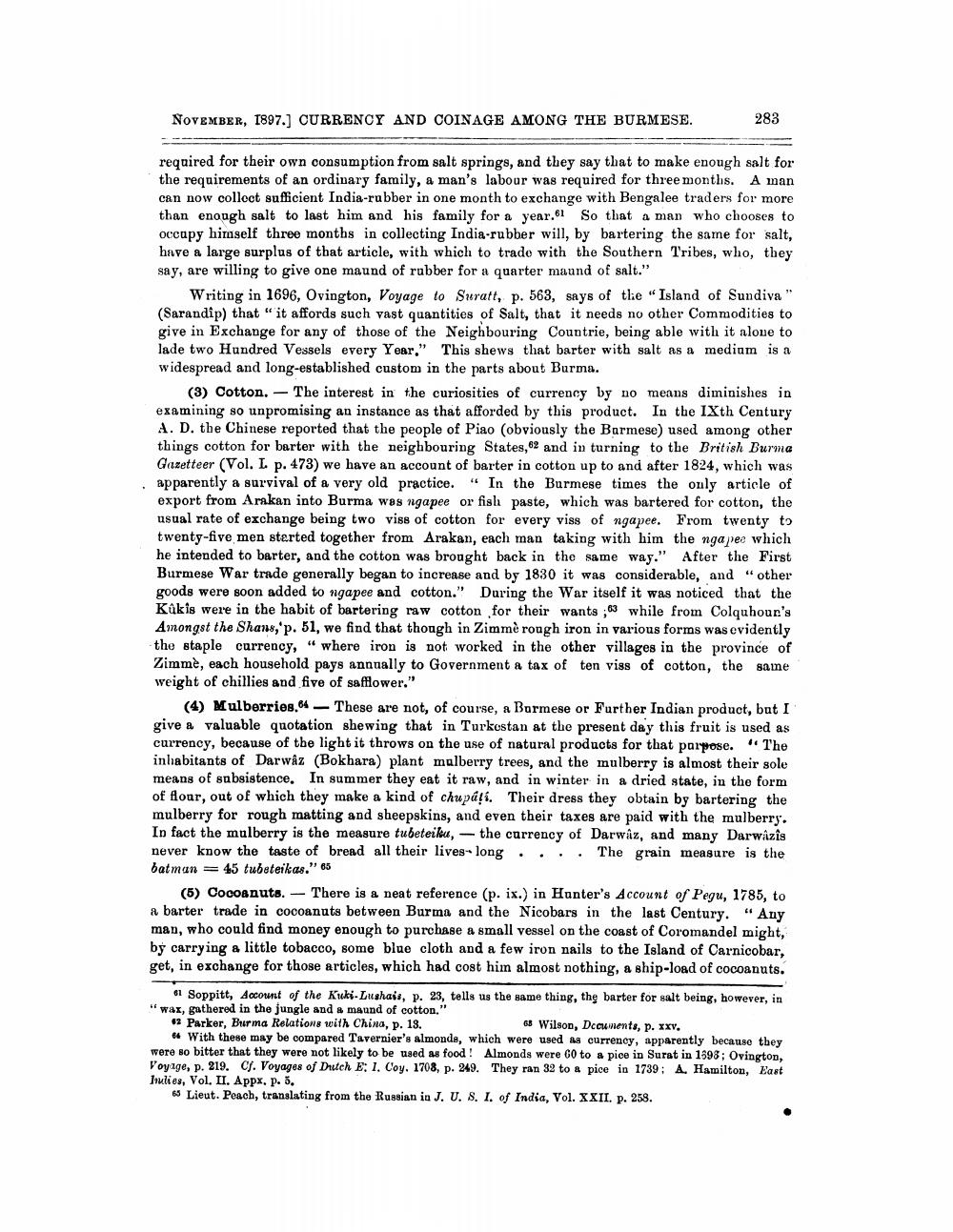________________
NOVEMBER, 1897.] CURRENCY AND COINAGE AMONG THE BURMESE.
283
required for their own consumption from salt springs, and they say that to make enough salt for the requirements of an ordinary family, a man's labour was required for three months. A man can now colloct sufficient India-rubber in one month to exchange with Bengalee traders for more than enough salt to last him and his family for a year.61 So that a man who chooses to occupy himself three months in collecting India-rubber will, by bartering the same for salt, have a large surplus of that article, with which to trade with the Southern Tribes, who, they say, are willing to give one maund of rubber for a quarter maand of salt."
Writing in 1696, Ovington, Voyage to Suratt, p. 563, says of the Island of Sundiva" (Sarandip) that "it affords such vast quantities of Salt, that it needs no other Commodities to give in Exchange for any of those of the Neighbouring Countrie, being able with it alone to lade two Hundred Vessels every Year," This shews that barter with salt as a medium is a widespread and long-established custom in the parts about Burma.
(3) Cotton. – The interest in the curiosities of currency by no means diminishes in examining so unpromising an instance as that afforded by this product. In the IXth Century A. D. the Chinese reported that the people of Piao (obviously the Barmese) used among other things cotton for barter with the neighbouring States, 62 and in turning to the British Burma Gazetteer (Vol. L p. 473) we have an account of barter in cotton up to and after 1824, which was apparently a survival of a very old practice." In the Burmese times the only article of export from Arakan into Burma was ngapee or fish paste, which was bartered for cotton, the usual rate of exchange being two viss of cotton for every viss of ngapee. From twenty to twenty-five men started together from Arakan, each man taking with him the nga pes which he intended to barter, and the cotton was brought back in the same way." After the First Burmese War trade generally began to increase and by 1830 it was considerable, and other goods were soon added to ngapee and cotton." During the War itself it was noticed that the Kúkis were in the habit of bartering raw cotton for their wants ;63 while from Colquhoun's Amongst the Shans, p. 51, we find that though in Zimme rough iron in various forms was evidently the staple currency," where iron is not worked in the other villages in the province of Zimme, each household pays annually to Government a tax of ten viss of cotton, the same weight of chillies and five of safflower."
(4) Mulberries,64 - These are not, of course, a Burmese or Further Indian product, but I give a valuable quotation shewing that in Turkestan at the present day this fruit is used as currency, because of the light it throws on the use of natural products for that parpose. "The inliabitants of Darwaz (Bokhara) plant mulberry trees, and the mulberry is almost their sole means of subsistence. In summer they eat it raw, and in winter in a dried state, in the form of flour, out of which they make a kind of chupáli. Their dress they obtain by bartering the mulberry for rough matting and sheepskins, and even their taxes are paid with the mulberry. In fact the mulberry is the measure tubeteiku, - the currency of Darwaz, and many Darwazis never know the taste of bread all their lives- long.... The grain measure is the batman = 45 tubsteikas." 65
(5) Cocoanuts. There is a neat reference (p. ix.) in Hunter's Account of Pegu, 1785, to a barter trade in cocoanuts between Burma and the Nicobars in the last Century. "Any man, who could find money enough to purchase a small vessel on the coast of Coromandel might, by carrying a little tobacco, some blue cloth and a few iron nails to the Island of Carnicobar, get, in exchange for those articles, which had cost him almost nothing, a ship-load of cocoanuts.
61 Soppitt, Account of the KickiLushait, p. 23, tells us the same thing, thg barter for salt being, however, in "wax, gathered in the jungle and a maund of cotton." "2 Parker, Burma Relations with China, p. 13.
65 Wilson, Documents, p. xxv. " With these may be compared Tavernier's almonds, which were used as currency, apparently because they were so bitter that they were not likely to be used as food! Almonds were 60 to a pice in Surat in 1898; Ovington, Voyage, p. 219. Cf. Voyages of Dutch E: 1. Coy. 1708, p. 249. They ran 32 to a pioe in 1739A. Hamilton, East Irulies, Vol. II. Appx, p.
65 Lieut. Poach, translating from the Russian in J. U. 8. I. of India, Vol. XXII. p. 258.




